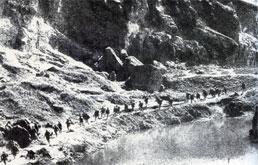Battle of Xinkou
| Battle of Xinkou | |||||||
|---|---|---|---|---|---|---|---|
| Part of the Second Sino-Japanese War | |||||||
 Chinese troops marching to defend Xinkou mountain passes |
|||||||
|
|||||||
| Belligerents | |||||||
|
|
|
||||||
| Commanders and leaders | |||||||
|
|
|
||||||
| Strength | |||||||
| 280,000 in 52 divisions | 140,000 in 4 divisions 350+ artillery guns 150+ tanks 300 aircraft |
||||||
| Casualties and losses | |||||||
| 100,000 dead, injured or missing | 20,000 killed Tens of thousands more wounded Dozens of tanks and 24+ planes |
||||||
The Battle of Xinkou (simplified Chinese: 忻口会战; traditional Chinese: 忻口會戰; pinyin: Xīnkǒu Huìzhàn) was decisive engagement of the Taiyuan Campaign, the second of the 22 major engagements between the National Revolutionary Army and Imperial Japanese Army during the Second Sino-Japanese War.
After battles at Nankou, the Chahar Expeditionary Force of the Japanese Kwangtung Army occupied Datong in Shanxi province, and began their assault on the Yenbei area. The Japanese Fifth Division started their attack from Hebei marching westwards and taking the towns of Guanglin, Linchou, Hungyuan in northwest Shanxi.
By late September, the Japanese commander Itagaki Seishiro ordered the fifth division and the Chahar Expeditionary Force to begin attacking the Chinese defense line along the inner Great Wall in Shanxi. The Commander of the 2nd War Zone, Yan Xishan, ordered Chinese troops to retreat and set up a defense line in Niangziguan and Pingxingguan.
Even after the Eighth Route Army led by Lin Biao successfully ambushed the Japanese at the Battle of Pingxingguan, the Chinese defenders suffered heavy casualties under Japanese artillery and tank assaults and were forced to retreat to Wutaishan to set up another defense line at Xinkou.
...
Wikipedia
